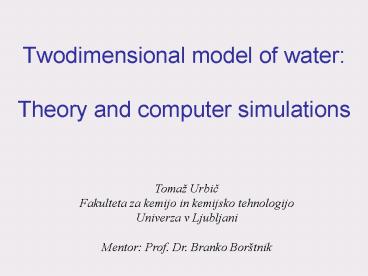Twodimensional model of water: Theory and computer simulations - PowerPoint PPT Presentation
1 / 25
Title:
Twodimensional model of water: Theory and computer simulations
Description:
Theory split potential in two parts: on strong asociative part and nonasociative ... associated fluids by Wertheim were applied to the Mercedes--Benz model of water ... – PowerPoint PPT presentation
Number of Views:28
Avg rating:3.0/5.0
Title: Twodimensional model of water: Theory and computer simulations
1
Twodimensional model of waterTheory and
computer simulations
Toma Urbic Fakulteta za kemijo in kemijsko
tehnologijo Univerza v Ljubljani Mentor Prof.
Dr. Branko Bortnik
2
SUMMARY
- Some facts about water
- Simple model of water
- Integral equation theory
- Thermodynamic perturbation theory
- Wertheims theory
- Results
- Conclusion
3
WATER
- is the most important substance on Earth
- molecular formula H2O
- H-O distances around 0.1 nm
- H-O-H angle around 104.5
4
WATER
- has some properties that distinguish it from
simpler liquids - the most important anomalies of pure water are
- high melting point (Tm0 C)
- high boiling point (Tb100 C)
- temperature of maximum density in the liquid
phase (4C) - large and almost constant heat capacity in liquid
phase - unusually low compresibility
5
WATER
6
HYDROGEN BOND
- The anomalies are related to the ability of water
molecules to form tetrahedrally coordinated
hydrogen bonds. - Directional bond (the O-H hydrogen atom being
donated to the O-atom acceptor atom on another
H2O molecule) - The bond strength depend on its length and angle
(exponential decay with distance)
7
Simple model of water
- Many models have been developed to capture water
properties - One difficulty is that simulations that include
a high degree of atomic realism are often
computationally limited and cannot reliably
predict the most subtle properties like heat
capacity - Hence there is a need for simplified models
- The simplest is the MB model, originally
proposed by Ben--Naim in 1971
8
MB model
9
MB model
10
MB model
11
Integral equation theory
- The total interaction of one particular
configuration is assumed to be given as a sum of
the pair-wise interaction.
12
Integral equation theory
- g2(r1,r2) is defined by the conditional
probability of finding a particle in volume dr1
at r1, and another particle in dr2 at r2,
regardless of the positions of all other
particles. In an isotropic fluid g2(r1,r2)
g2(r1-r2) g(r). - The total correlation function
- h(r) g(r) 1 measures an excess above the
ideal gas value which is 1.
13
Configurational integral Z(r1,.,rN) and the pair
distribution function g(r)
For ßU 0, we obtain the ideal contribution
ZVN.
14
Ornstein-Zernike integral eq. defines c(r)
For ? ? 0 the two particles are only directly
correlated and h (r) c(r) the second term is
due to the presence of all other particles in the
system!
2
The probability of finding a particle in dr is
changed due to the presence of particle 1 and is
given by ?h(r)dr. The 3rd particle makes a
contribution c(r-r)?h(r)dr.
?h(r)dr
1
15
The closure condition
The Ornstein-Zernike equation in form
- is merely a definition and another relation
between h(r) and c(r) (closure) is needed to
solve this equation. - For ?? 0 and r ? 8 an exact result is derived
showing that c(r) - ßu(r). This is the
simplest possible continuation.
16
HNC closures
- Diagrammatic expansion yields an exact equation
- HNC approximation follows for the bridge
graphs B(r) 0 only numerical solution is
possible.
17
Perturbation theory
- Structure of simple fluids is largely determined
by geometric factors associated with the packing
of molecular hard cores. - The properties of a given fluid can be related to
those of a hard-core reference system and the
atractive part of the potential being treated as
a perturbation. - The choice of the hard-core fluid as reference
system is an obvious one, since the thermodynamic
and structural properties are well known.
18
Hamiltonian of the system is written as
H0 is the Hammiltonian of hard-core fluid, while
19
Perturbation theory example
- Lennard-Jones fluid (Baker-Henderson)
20
(No Transcript)
21
Wertheimova teorija
- Modern liquid theories are based on Mayer
density series - For systems with weak interactions ( )
we got ideal gas - equation with this series.
- In case of strong interaction between pairs (
) the correct - eqution for ideal gas of dimers is
.
22
- To get the right equation of state we need to
calculate infinite series. - Wertheim developed the formalism which solved
this problem of infinite series. With this theory
we can study asociative fluids. - Theory split potential in two parts on strong
asociative part and nonasociative part. In our
case HB potential is asociative part and LJ
interaction non-asociative. - Because of spliting of the potential the density
of the molecules is splited into two parts into
density of asociated and density of nonasociated
molecules.
23
Results
Comparison for pair-correlation functions for MB
molecules between IET and MC simulations at
presure p0.19. Presented are the following
temperatures (a) T0.36, (b) T0.28, (c)
T0.24, (c) T0.21, (d) T0.18 and (e)
T0.16. MC results are presented with symbols
and IET results with solid line.
24
Results
Temperature dependence of termodynamic properties
of MB molecules (a) the molar volume, (b) the
thermal expansion coefficient, (c) heat capacity
at constant pressure and (c) the
isothermal Compressibility s obtained by the
Monte Carlo simulation (symbols), the
thermodynamic perturbation theory (continuous
line) and integral equation theory (dashed line).
1.0M
0.425M
0.2M
25
Conclusion
- Two statistical--mechanical theories developed
for associated fluids by Wertheim were applied
to the Mercedes--Benz model of water - Both theories qualitatively reproduce the
temperature trends of key thermodynamic
properties - Both theories improve at high temperatures,
where the orientational averaging approximation
is least problematic. - The direction for improvement is to solve the
orientationally dependent Ornstein--Zernike
equation.































